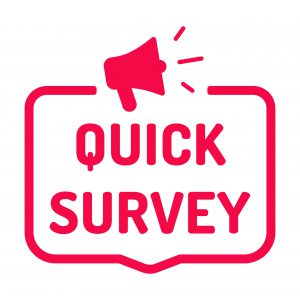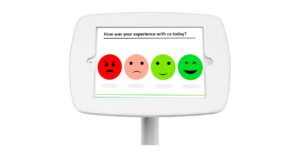Survey vs Feedback – Major Differences + 5 Quick Tips 👍🏼
What is the difference between a Survey vs Feedback?
A survey is generally a series of specific questions that are asked as part of an overall survey whereas feedback is a collection of information and is tied to specific questions rather than entire surveys. Surveys are usually pushed to the user asking for them to answer a series of questions compared to feedback that is usually received more naturally where the user is sharing their feedback.
What is Feedback?
Feedback is the collection of information in a structure format. This can be specific to a company, product, person or even an experience. Feedback is generally collected by asking a specific question such as, “How was your experience today?”. Feedback is often received in a more natural format and more open ended. Response rates can be much higher when asking for feedback since it’s more natural. One Click Feedback can drive an even higher response rate since it’s quick and easy to complete.
What is a Survey?
A survey usually consists of a series of questions that are being asked. This could be related to collecting feedback or doing research on a specific topic. Surveys are usually pushed to the end user and asked to answer specific questions. Survey data is more in-depth and detailed, however, the response rates are typically much lower than feedback response rates.
What is a feedback survey?
A feedback survey is a structured questionnaire used to gather the opinions and insights from a specified group of users (example: customers, employees, users, etc) about their experience with a product, service or experience. A feedback survey can measure their satisfaction, identify areas for improvement and ultimately give data to make informed decisions for improvement.
Survey vs Feedback OR Survey + Feedback?
Tips on Drafting Customer Feedback Survey Questions
- When drafting a Feedback Survey we have found it very important to ask the right questions. If you ask misleading or confusing questions then you can expect your survey results to be exactly that. B2B Customer satisfaction survey questions are most effective when they are short, concise and relevant.
- We recommend using tools like ‘conditional logic’ to ask follow up questions depending on how previous questions were answered. This will help make all survey questions relevant.
- Don’t change the survey questions too often. Feedback data is useless without relative sense. This means that if the average score on a survey is 80%, this could be very good if historically it’s been 70%, or this could be very bad if the average has been 90% in the past.
- It’s all about the Frictionless Feedback. The harder you make it for customers to complete your feedback survey the fewer response you can expect. Furthermore, the feedback you do receive will be extreme (very happy or very angry).
- Based on our years of experience we found it best to create the same Feedback Questionnaire across multiple channels. Not all customers can be expected to share feedback the same way at the same time. Meaning if you send out a survey via email 2 days after they purchase, this might only attract a portion of the customers to share their feedback.

Request Information on SurveyStance
What is the Importance of Survey Feedback?
- It can be up to 25x more expensive to get a new customer compared to keeping an existing customer.
- If you don’t ask for feedback, you probably won’t receive it. Customer feedback is imperative to ensure you are delivering at the highest level for your customers.
- Customers want to be heard. By not providing a method for customers to share their feedback they will use 3rd party review sites like Yelp, Google, etc.
- Customer Survey Feedback is not only important to collect from customers, it’s also important to collect employee feedback. Collecting employee feedback and staying connected is a great way to keep a pulse on employee happiness and reduce employee turnover.
Feedback Survey Made Easy w/ One Quick Tap!

How to write a feedback survey?
Writing an effective feedback survey is the key to a successful feedback program. To start, the survey questions should be clear and concise, the respondent should easily understand the intent of the question. Next, the survey question must be easy to answer. For example, requiring open text responses is not ideal for most questions. We recommend using images or emojis to allow the user to quickly click and answer the question. Also, it’s best to use conditional logic to route the user to specific survey questions based on their previous inputs. This will help ask the right questions which will make analyzing the feedback results much easier.
The Secret Sauce to Efficient and Actionable Feedback
Surveys are only valuable when you ask the right questions. That’s why building and deploying a useful and helpful survey to gather feedback is no small feat. We see too often teams creating complex surveys for feedback and in the end can’t understand the results.
Crafting a smart feedback survey is an art and not a science. Ask the right questions and you unlock a gold mine of customer insights with clear, actionable data that guides your business to success. Avoid complex pitfalls and instead, build surveys that speak your customer’s language and reveal their needs.
Although surveys and feedback have differences, they also share similarities. A feedback survey is a combination of both. It aims to collect information from your customers or employees in an efficient way.
Businesses can benefit from a feedback survey because they can gain valuable information from their client’s experience and they can improve their performance based on the client’s responses. A popular example of this is our restaurant customer satisfaction survey where quick feedback is collected directly at the point of sale.
A great feedback survey asks the right questions to the users at the right time in the process to get efficient results. Learn more about our survey app for iPad.
For additional information on survey vs feedback and how SurveyStance helps companies collect customer feedback, please check out our Survey Kiosk to start capturing feedback.
Also for check out our feedback survey examples for some new ideas!

Tips on creating a feedback survey for customers or employees.
1. Create your survey.
This sounds like an obvious step, but it’s the most important. Making sure you not only use the best survey platform, but also make sure you are writing the best survey questions to get the feedback you’re looking for.
2. Define your survey audience.
Most surveys are designed to collect customer feedback, but don’t forget about your employees, vendors, users, etc. Collecting feedback from all angles will help give you a more complete picture. We find this is an often missed step when collecting feedback.
3. Collect the feedback
Surveys can be sent via e-mail (old fashion link), most companies we work with see a very low response rate when using this method. Feedback can be collected in a more modern way using Emoji Surveys via Feedback Kiosks for in-person real time feedback or embedded emoji surveys in email signatures or support ticket templates.
4. Collect the results.
Once you’ve collected enough responses, take a look at the results and see what people had to say. Using some type of survey template can help you organize this data to be presentable.
5. Take action based on the feedback.
Remember, it’s not only about collecting the feedback… you have to act on the feedback to make improvements that will improve the customer experience and drive more business.
Sending these feedback surveys can really be a great way to learn about what others think. While it can be time consuming to get setup and monitor, it’s really imperative to future success.
Popular Types of Feedback Surveys
Net Promoter Score (NPS):- Net Promoter Score (NPS) is a metric used to measure customer loyalty and satisfaction based on a single question: “How likely are you to recommend our product/service to others?” Customers respond on a scale from 0 to 10, and the NPS categorizes them as Promoters, Passives, or Detractors, providing a concise and actionable indicator of overall customer sentiment for businesses.
- Companies utilize NPS to gauge customer loyalty by tracking the percentage of Promoters (loyal enthusiasts) and Detractors (discontented customers). For instance, a high NPS can signify strong loyalty, while a focus on converting Detractors into Promoters reflects a commitment to enhancing overall customer satisfaction and brand advocacy.
- Likert scale questions enable nuanced responses by offering a spectrum of options, allowing survey respondents to express varied degrees of agreement or disagreement and providing richer insights into their attitudes.
- Likert scales make it easier to measure users opinions by turning subjective feelings into actual data which, helps to quantify how much they agree or disagree with a statement.
- Customer Effort Score (CES) measures how easy or difficult it is for customers to interact with a company’s products or services, typically based on the question: “How much effort did you have to put forth to handle your request?” CES is relevant in evaluating the efficiency of customer interactions, providing valuable insights into the overall ease of the customer experience and complementing broader customer satisfaction metrics by specifically addressing the aspect of ease of use or interaction.
Author

Natalie Nicole
This post was written by Natalie Nicole, a seasoned customer experience expert with over a decade of expertise in crafting impactful feedback surveys. Through her work with diverse businesses, Natalie has helped countless teams unlock the power of customer insights to drive positive change. Her passion lies in bridging the gap between customer voices and actionable data, empowering businesses to listen, learn, and thrive.